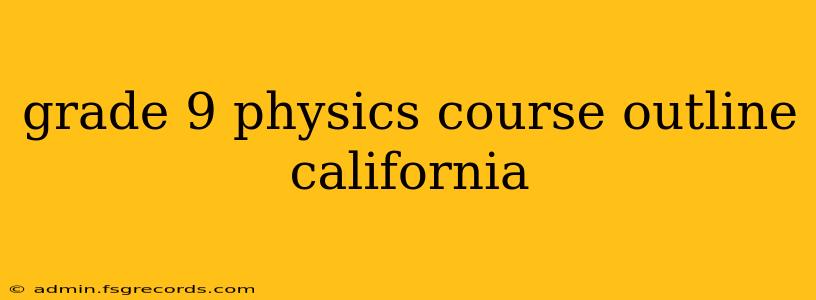This outline details a potential structure for a Grade 9 Physics course in California, aligning with Next Generation Science Standards (NGSS) and common curriculum expectations. The specific topics and depth of coverage may vary depending on the school and teacher. This outline emphasizes hands-on activities and real-world applications to enhance understanding.
Course Goal: To develop a foundational understanding of fundamental physics concepts, including motion, forces, energy, and waves, through inquiry-based learning, experimentation, and problem-solving.
Units of Study:
Unit 1: Introduction to Physics & Measurement (approx. 2 weeks)
- What is Physics? Exploring the nature of physics, its branches, and its role in understanding the world. Discussion of the scientific method.
- Measurement and Units: SI units, significant figures, scientific notation, dimensional analysis. Hands-on activities involving measurement tools (rulers, balances, graduated cylinders).
- Uncertainty and Error: Understanding sources of error in measurements, calculating percent error, and representing data graphically.
Unit 2: Motion and Forces (approx. 4 weeks)
- Kinematics: Describing motion using position, displacement, velocity, and acceleration. Graphical representation of motion (position-time graphs, velocity-time graphs).
- Newton's Laws of Motion: Understanding inertia, force, and acceleration. Exploring Newton's Second and Third Laws through experiments involving forces and motion (e.g., inclined planes, Atwood machines).
- Freefall and Gravity: Understanding the concept of acceleration due to gravity, projectile motion (basic), and exploring applications of Newton's laws in everyday scenarios.
Unit 3: Energy (approx. 4 weeks)
- Work and Energy: Defining work, potential energy (gravitational and elastic), kinetic energy. Conservation of energy – applying the principle to different scenarios (e.g., roller coasters, pendulums).
- Power: Calculating power and understanding its relationship to work and energy. Real-world examples of power in different contexts.
- Energy Transformations: Exploring various forms of energy (e.g., mechanical, thermal, chemical, electrical) and how energy transforms from one form to another. Efficiency and energy loss.
Unit 4: Waves (approx. 3 weeks)
- Wave Properties: Defining transverse and longitudinal waves, wavelength, frequency, amplitude, speed. Hands-on activities demonstrating wave properties (e.g., wave tanks, slinky demonstrations).
- Sound: Understanding the nature of sound waves, speed of sound, and the relationship between frequency and pitch. Exploring different aspects of sound, like resonance and interference.
- Light: Introduction to the wave nature of light, reflection, refraction, and the electromagnetic spectrum (brief overview).
Unit 5: Simple Machines (approx. 2 weeks)
- Mechanical Advantage: Understanding how simple machines (levers, pulleys, inclined planes, screws, wedges) make work easier by modifying force and distance. Calculating mechanical advantage and efficiency. Hands-on experiments with simple machines.
Assessment:
- Formative Assessments: Regular quizzes, in-class activities, lab reports, and participation in discussions.
- Summative Assessments: Unit tests covering key concepts and problem-solving skills, a final exam encompassing the entire course, and potentially a science fair project related to physics.
Lab Activities: A significant portion of the course will involve hands-on laboratory experiments designed to reinforce concepts and develop experimental skills. Examples include:
- Measuring motion using motion sensors and data-logging software.
- Investigating Newton's laws using force probes and carts.
- Exploring energy transformations using roller coasters or pendulums.
- Demonstrating wave properties using wave tanks and other materials.
- Building and testing simple machines.
This outline provides a framework. Individual teachers may adjust the pacing and content to fit their students' needs and available resources. The emphasis should be on developing a conceptual understanding of physics principles through inquiry-based learning and active participation.

